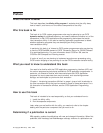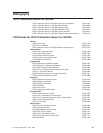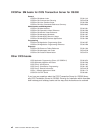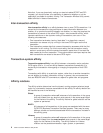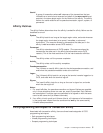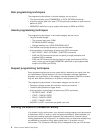
Chapter 1. Introducing transaction affinities
This chapter provides a brief introduction to the concept of transaction affinities and
the associated CICS programming techniques, and highlights the significance of
transaction affinities in a dynamic routing (known in previous releases of CICS as
dynamic
transaction
routing) environment. For more information about transaction
affinities, see the
CICS Application Programming Guide
.
This chapter introduces the following topics:
v “The benefits of dynamic routing” on page 3
v “Transaction affinities” on page 3
v “CICS programming techniques for transaction affinity” on page 5
v “Avoiding the effects of transaction affinity” on page 6
v “Protecting applications from one another” on page 7
CICS has been handling customers’ online transaction processing requirements for
over thirty years. In that time, it has been extensively enhanced to meet the
ever-growing needs of business applications, and to exploit the capabilities of
modern computer processors and communication systems. One of the most
significant enhancements in recent times is the addition of the dynamic routing
facility.
Originally, a full-function CICS ran in a single address space (region) within the
MVS environment. Currently, most CICS users use some form of
intercommunications to operate multiple, interconnected, CICS regions (a
CICSplex). Using the CICS multiregion operation (MRO) facility, a CICSplex
typically consists of one or more terminal-owning regions (TOR), and a number of
application-owning regions to which the TORs route the incoming transactions for
processing. The CICSPlex SM element of CICS Transaction Server for OS/390
Release 3 includes a workload management component that optimizes processor
capacity by dynamically routing transactions to whichever CICS region is the most
appropriate at the time, taking into account any transaction affinities that exist. For
an introduction to CICSPlex SM, see
CICSPlex SM Concepts and Planning
; for
information about CICSPlex SM workload management, see
CICSPlex SM
Managing Workloads
.
Before CICS Transaction Server for OS/390 Release 3, TORs routed transactions to
the AORs predefined in transaction resource definitions by the system programmer.
This static form of transaction routing adds to the system administration burden of
the system programmer, because when transaction workloads have to be
rebalanced across the AORs, transaction resource definitions have to be modified
accordingly.
CICS A CICS B
Terminal-Owning Application-Owning
Region (TOR) Region (AOR)
End-user MRO
terminal CICS Relay User
Transaction links Transaction
Figure 1. The CICS transaction routing facility
© Copyright IBM Corp. 1994, 1999 1
|
|
|





